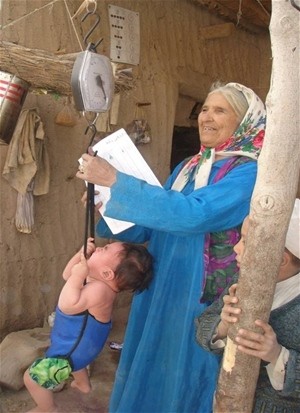
A community health worker checks a child’s weight gain during a growth monitoring session in Jawzjan Province.
Dr. Zarbadshah Jabarkhail
Communities work together to improve the nutritional status of their children.
13 JUNE 2010 | JAWZJAN PROVINCE, AFGHANISTAN
With sadness in her eyes, 16-year-old Fatima cradles her baby boy. Her son is often ill and has remained small compared to other children. She doesn’t know how to help him. Fatima’s story is all too common in Afghanistan, where more than 50 percent of children are chronically malnourished. Additionally, malnutrition is responsible for approximately 50 percent of child deaths in the country.
Addressing nutrition is difficult in Afghanistan due to high female illiteracy rates and irregular access to health facilities by women. Community health workers (CHWs) can promote better nutritional practices but they struggle to cover all the households in their communities.
USAID’s BASICS (Basic Support for Institutionalizing Child Survival) project has worked with the Afghan Ministry of Public Health to develop a community-based approach to detect malnutrition in children. The approach catches malnutrition early by monitoring children’s monthly growth through family health action groups (FHAGs) made up of 10 to 15 households.
The approach is simple, yet effective. A member of the community FHAG convenes monthly weighing sessions for all children under age two at a central place in the village, with the CHW present. Each child’s weight gain or loss is marked on a simple pictorial chart developed especially for use by illiterate CHWs and mothers. For children with insufficient weight gain, a FHAG member and CHW do an in-depth examination of feeding practices with the mother. After exploring the types of food eaten, the quantities consumed, and the frequency of the feedings, they make an agreement with the mother on how to improve the child’s diet. They also share health messages about vaccination, hand washing, prenatal care, and birth spacing. Any child who has not had a weight gain for two successive months is referred to the nearest health facility.
In the first five districts participating in community-based growth monitoring, more than 80 percent of the children are showing adequate weight gain. Fatima is happy her son is now gaining weight and has been healthier since she started attending the community growth monitoring sessions. This community approach is improving the nutritional status of children across Afghanistan.







Comment
Make a general inquiry or suggest an improvement.